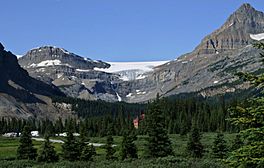Bow Glacier facts for kids
Quick facts for kids Bow Glacier |
|
|---|---|

Bow Glacier above Bow Lake
|
|
| Coordinates | 51°38′47″N 116°30′40″W / 51.64639°N 116.51111°W |
| Terminus | Moraine |
| Status | Receding |
Bow Glacier is a cool glacier located in Banff National Park, Alberta, Canada. It's about 37 kilometers (23 miles) northwest of Lake Louise. You can see this amazing glacier from the Icefields Parkway, a famous scenic road.
Bow Glacier is part of a much bigger ice area called the Wapta Icefield. This icefield sits right on the Continental Divide, which is like a giant ridge that separates rivers flowing to different oceans. Water melting from Bow Glacier flows into Bow Lake and then into the Bow River. Long ago, this powerful glacier even helped carve out the beautiful Bow Valley as it slowly melted back after the last big ice age.
Contents
Why is Bow Glacier Important?
A Source of Water
Bow Glacier is super important because it provides fresh water. As the glacier melts, its water feeds into Bow Lake. This lake is the starting point for the Bow River. The Bow River is a major river in Alberta. It provides water for many communities.
Shaping the Land
Glaciers are like giant, slow-moving rivers of ice. Over thousands of years, they can change the land. Bow Glacier helped create the Bow Valley. It carved out the valley as it moved. This process shaped the mountains and valleys we see today.
How is Bow Glacier Changing?
Getting Smaller Over Time
Since around 1850, after a period called the Little Ice Age, Bow Glacier has been getting smaller. This process is called "retreating." Between 1850 and 1953, the glacier shrank by about 1,100 meters (3,600 feet). It has continued to retreat even more since then.
New Lakes and Sediment
As the glacier melts and retreats, new things appear. A new lake has formed where the glacier's end used to be. This lake is at the "terminal moraine," which is a pile of rocks and dirt left behind by the glacier.
The melting ice also causes more soil to wash into Bow Lake. This is because the glacier no longer protects the ground. This extra soil creates a small delta at the western end of the lake. A delta is a landform that looks like a triangle, formed when a river deposits sediment as it enters a larger body of water.


